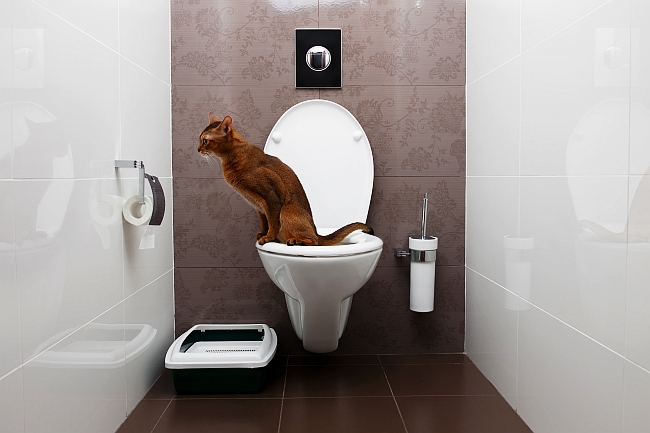
Most litter boxes have a tendency to stink up the home if they are not cleaned regularly. One of the most unpleasant jobs as a pet owner is having to deal with animal waste (which can even be downright dangerous if you are pregnant). Imagine a world where the only involvement you would have with your kitty’s waste, is walking into the bathroom and flushing the toilet! Though the very title of this blog might cause some to laugh out loud incredulously at the concept of cat using a human toilet, we have seen it accomplished and know that it is possible to potty train a cat. Here are some simple steps that you can implement to teach your cat to live litter-box free
1. Put your litter box in the bathroom, right next to the toilet seat. Every few days, move the litter box higher and higher by placing a stool, or several books underneath it, until your cat learn to jump up into the floor of litter box. (Obviously this will entail you removing the covering or “roof” of the litter box so that he will have easy access.)
2. When the cat is used to doing his business in the litter box next to the toilet, start to transition the litter box on top of the closed toilet bowl itself. (Whenever you use the restroom, simply set the litter box on the ground, and replace it atop the toilet before you exit.)
3. Next start using a center-toilet litter box. These can be purchased at pet stores (for example: one is the CitiKitty Training seat, or Litter Kwitter, etc.) or even made at home using a strong foil cooking dish. Be sure to add a helpful scooping of flushable litter so that the transition will be smooth and familiar for your cat.
4. After several days, adjust the kitty training seat to the next product of the stage. The first one would have had a small hole in the middle to let waste fall into the toilet. There should be 2 or 3 other training lids that each have larger and larger holes until the cat starts training himself to sit on the edge of the toilet seat without any help. If you are doing this with the cooking foil or plastic lid product, cut a hole bigger and bigger every few days while the cats are training. Keep doing so until the hole in the foil is almost as wide as the toilet seat, causing your cat to keep the bulk of his weight on the toilet seat itself.
5. If your cat seems comfortable with the practice after a few weeks of using the toilet, remove the finally training lid as the kitty should be able to sustain and balance his own weight on the toilet seat.
Make sure you keep disinfectant wipes and anti-bacteria sprays close at hand once you regularly start sharing your toilet with the kitty. Even if it looks as if you cat hasn’t been on the toilet yet, giving the seat a quick wipe down will help keep everything more hygienic and safe in your home.

